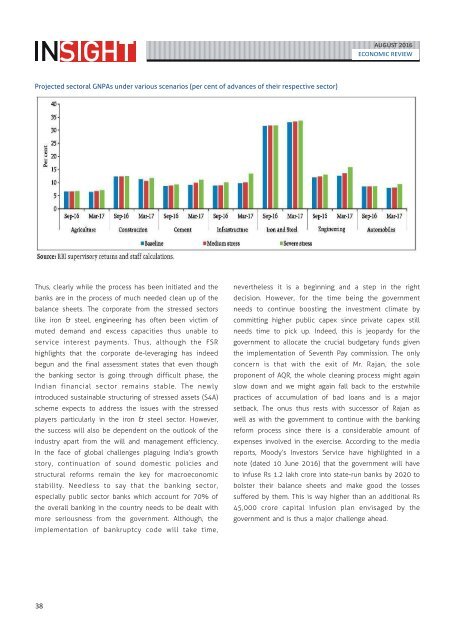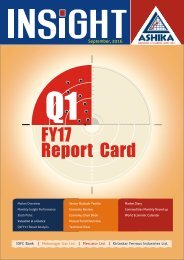Ashika Monthly Insight August 2016
You also want an ePaper? Increase the reach of your titles
YUMPU automatically turns print PDFs into web optimized ePapers that Google loves.
AUGUST <strong>2016</strong><br />
ECONOMIC REVIEW<br />
Projected sectoral GNPAs under various scenarios (per cent of advances of their respective sector)<br />
Thus, clearly while the process has been initiated and the<br />
banks are in the process of much needed clean up of the<br />
balance sheets. The corporate from the stressed sectors<br />
like iron & steel, engineering has often been victim of<br />
muted demand and excess capacities thus unable to<br />
service interest payments. Thus, although the FSR<br />
highlights that the corporate de-leveraging has indeed<br />
begun and the final assessment states that even though<br />
the banking sector is going through difficult phase, the<br />
Indian financial sector remains stable. The newly<br />
introduced sustainable structuring of stressed assets (S4A)<br />
scheme expects to address the issues with the stressed<br />
players particularly in the iron & steel sector. However,<br />
the success will also be dependent on the outlook of the<br />
industry apart from the will and management efficiency.<br />
In the face of global challenges plaguing India’s growth<br />
story, continuation of sound domestic policies and<br />
structural reforms remain the key for macroeconomic<br />
stability. Needless to say that the banking sector,<br />
especially public sector banks which account for 70% of<br />
the overall banking in the country needs to be dealt with<br />
more seriousness from the government. Although, the<br />
implementation of bankruptcy code will take time,<br />
nevertheless it is a beginning and a step in the right<br />
decision. However, for the time being the government<br />
needs to continue boosting the investment climate by<br />
committing higher public capex since private capex still<br />
needs time to pick up. Indeed, this is jeopardy for the<br />
government to allocate the crucial budgetary funds given<br />
the implementation of Seventh Pay commission. The only<br />
concern is that with the exit of Mr. Rajan, the sole<br />
proponent of AQR, the whole cleaning process might again<br />
slow down and we might again fall back to the erstwhile<br />
practices of accumulation of bad loans and is a major<br />
setback. The onus thus rests with successor of Rajan as<br />
well as with the government to continue with the banking<br />
reform process since there is a considerable amount of<br />
expenses involved in the exercise. According to the media<br />
reports, Moody’s Investors Service have highlighted in a<br />
note (dated 10 June <strong>2016</strong>) that the government will have<br />
to infuse Rs 1.2 lakh crore into state-run banks by 2020 to<br />
bolster their balance sheets and make good the losses<br />
suffered by them. This is way higher than an additional Rs<br />
45,000 crore capital infusion plan envisaged by the<br />
government and is thus a major challenge ahead.<br />
38






